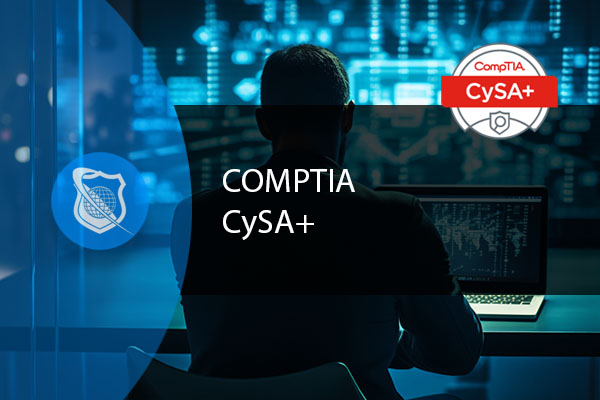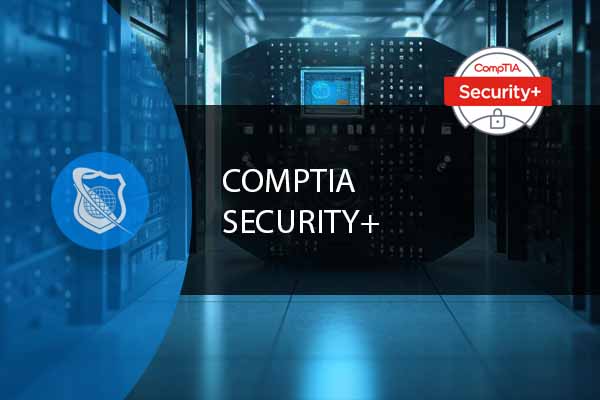Safeguarding the endpoints of your network is paramount and endpoint security tools and toolsets play a critical role in identifying and mitigating malicious activities, ensuring the integrity and confidentiality of your data. This blog delves into the common tools for detecting malicious activity, covering packet capture, log analysis, endpoint security, DNS tools, file analysis, and sandboxing. These are essential areas of focus for anyone preparing for the CYSA exam or looking to bolster their network security.

CompTIA CySA+ Training
Ready to fortify digital landscapes? Unleash your potential with our CySA+ course. Master behavioral analytics, shield networks, and become a certified defender against cyber threats. Elevate your security prowess, ace the CompTIA CySA+ (CS0-003) exam, and secure a resilient future for organizations
Packet Capture
Packet capture tools, such as TCPdump, are fundamental in monitoring network traffic. They allow cybersecurity professionals to inspect the details of the traffic on a network, identifying anomalies such as unexpected IP addresses, dubious domain names, or potentially malicious packets. Whether deployed on Linux, Linux servers, or Windows, packet capture tools are indispensable for a detailed network traffic analysis.
Packet capture tools are essential for network diagnostics and security analysis, allowing professionals to monitor and analyze network traffic in real time or from recorded sessions. Here’s a detailed look at some of the most widely used packet capture tools, covering their names, advantages, disadvantages, vendors, ease of use, and pricing.
1. Wireshark
- Vendor: The Wireshark team
- Pros:
- Widely regarded as the industry standard for network protocol analysis.
- Offers deep inspection of hundreds of protocols, with more being added regularly.
- Features a user-friendly interface with powerful filtering and search capabilities.
- Cons:
- Can be overwhelming for beginners due to its extensive range of features and data.
- Requires substantial system resources for analyzing large volumes of traffic.
- Ease of Use: Moderate to High (depending on the user’s experience level).
- Pricing: Free (Open Source).
2. TCPdump
- Vendor: Originally developed by Lawrence Berkeley National Laboratory
- Pros:
- Lightweight and command-line based, making it ideal for use on servers or other headless systems.
- Highly versatile, capable of running on a wide variety of operating systems.
- Cons:
- Lacks a graphical user interface, which can make analysis more challenging for those not comfortable with command-line tools.
- Filtering and analysis capabilities are less user-friendly compared to tools with GUIs.
- Ease of Use: Moderate to Low (primarily for users comfortable with the command line).
- Pricing: Free (Open Source).
3. Tshark
- Vendor: Part of the Wireshark project
- Pros:
- Offers the deep packet analysis capabilities of Wireshark in a command-line tool.
- Suitable for automated tasks and remote use.
- Cons:
- Like TCPdump, it may be challenging for users not familiar with command-line interfaces.
- Lacks the immediate visual analysis benefits of a graphical interface.
- Ease of Use: Moderate (best for users with command-line proficiency).
- Pricing: Free (Open Source).
4. Pcapng
- Vendor: Part of the Wireshark project (file format rather than a tool)
- Pros:
- Next-generation pcap file format that offers extended features such as annotations, improved time stamping, and support for capturing on multiple interfaces simultaneously.
- Cons:
- As a file format, it requires compatible software (like Wireshark) to analyze the data.
- Not a standalone capture tool but important for compatibility and advanced features in analysis.
- Ease of Use: N/A (Depends on the software used for analysis).
- Pricing: Free (Standard supported by various tools).

Information Security Manager Career Path
Propel your career forward and be part of an essential member of any management team as an Information Security Manager. This advanced training series is designed specifically for those want to move up into a management position in the IT field.
5. Moloch
- Vendor: AOL
- Pros:
- Designed for very large scale packet capturing and analysis.
- Features a web interface for exploring captured data without requiring extensive command-line knowledge.
- Cons:
- Setup and deployment can be complex, geared more towards enterprise environments.
- Requires significant resources for storage and processing, especially at scale.
- Ease of Use: Moderate (Web interface simplifies analysis, but setup is non-trivial).
- Pricing: Free (Open Source).
Each of these tools offers unique capabilities and trade-offs, catering to different needs and expertise levels. While free, open-source options like Wireshark, TCPdump, and Tshark are highly popular for their robust features and flexibility, they may require a learning curve to master fully. Tools like Moloch cater to enterprise needs, offering scalable solutions for large-scale packet capture and analysis. Selecting the right tool often depends on the specific requirements of the task, including the scale of packet capture needed, the user’s familiarity with command-line interfaces, and the need for real-time versus post-hoc analysis.
Log Analysis Tools
Log analysis tools, including Security Information and Event Management (SIEM) tools, Security Orchestration, Automation, and Response (SOAR) systems, and Intrusion Detection Systems/Intrusion Prevention Systems (IDS/IPS), are crucial for analyzing log files and managing data. These tools help in detecting, preventing, and responding to security incidents by analyzing vast amounts of log data to identify patterns of malicious activity.
Log analysis tools are crucial for cybersecurity and network administration, providing insights into system performance, security incidents, and operational trends. These tools help in parsing, aggregating, and analyzing log data from various sources. Below is a detailed exploration of some key log analysis tools, including their features, pros and cons, vendors, ease of use, and whether they are free or paid.
1. Splunk
- Vendor: Splunk Inc.
- Pros:
- Comprehensive log management and analysis solution with powerful searching capabilities.
- Highly scalable, supporting data ingestion from multiple sources at a high rate.
- Offers extensive add-ons for various integrations and functionalities.
- Cons:
- Pricing can be prohibitive for small to medium-sized businesses due to its data-based pricing model.
- Complex setup and steep learning curve for new users.
- Ease of Use: Moderate to High (depending on the complexity of the use case).
- Pricing: Paid, with a free trial and a limited free version for smaller use cases.
2. ELK Stack (Elasticsearch, Logstash, Kibana)
- Vendor: Elastic
- Pros:
- Open-source and highly customizable stack for log parsing, visualization, and storage.
- ElasticSearch provides powerful search capabilities, while Kibana offers intuitive data visualization.
- Logstash allows for flexible data processing and enrichment.
- Cons:
- Can require significant resources for setup and operation, especially at scale.
- Integration of three separate tools can complicate maintenance and scaling.
- Ease of Use: Moderate (requires some technical expertise for setup and optimization).
- Pricing: Free (Open Source) with paid options for enterprise features and support.
3. Graylog
- Vendor: Graylog, Inc.
- Pros:
- Open-source log management tool that is easy to use for capturing, storing, and enabling real-time analysis of terabytes of machine data.
- Offers a centralized log management solution with an intuitive user interface.
- Robust alerting and reporting capabilities.
- Cons:
- Might require additional plugins or integrations for advanced analytics.
- While easier than some alternatives, it still requires a fair amount of setup and configuration.
- Ease of Use: Moderate (designed to be more accessible than some alternatives).
- Pricing: Free (Open Source) with enterprise options available.
4. LogRhythm
- Vendor: LogRhythm, Inc.
- Pros:
- Provides a comprehensive suite for log management and SIEM, including advanced security analytics.
- Features built-in modules for compliance management and network monitoring.
- Strong focus on security with integrated incident response and threat detection capabilities.
- Cons:
- Can be complex to configure and manage, with a significant learning curve.
- Pricing may be high, particularly for small organizations.
- Ease of Use: Moderate to High (geared towards professionals with specific security analysis needs).
- Pricing: Paid, with pricing available upon request.
5. SolarWinds Log & Event Manager
- Vendor: SolarWinds Worldwide, LLC
- Pros:
- Offers powerful log management, correlation, and real-time event detection.
- Integrates well with other SolarWinds products for comprehensive IT management.
- User-friendly interface with drag-and-drop functionality for building correlation rules.
- Cons:
- Pricing can be an issue for smaller businesses.
- Some users report a learning curve in leveraging all its features effectively.
- Ease of Use: Moderate (focuses on simplifying complex log management tasks).
- Pricing: Paid, with a free trial available.
Selecting the right log analysis tool depends on several factors, including the specific needs of the business, the volume of data to be analyzed, the technical expertise of the users, and budget constraints. Open-source solutions like the ELK Stack and Graylog offer flexibility and customization at the cost of a potentially steeper learning curve and the need for more hands-on maintenance. In contrast, commercial products like Splunk and LogRhythm provide comprehensive, out-of-the-box solutions with support and advanced features, albeit at a higher cost.

Information Security Analyst Career Path
An Information Security Analyst plays a pivotal role in safeguarding an organization’s digital infrastructure and sensitive data. This job involves a blend of technical expertise, vigilance, and continuous learning to protect against ever-evolving cyber threats.
Endpoint Security
In today’s enterprise environments, securing endpoints—be it servers, desktops, laptops, or mobile devices—is non-negotiable. Endpoint security solutions, such as Microsoft Defender, CrowdStrike Falcon, Trend Micro, and SentinelOne, offer comprehensive protection against threats. They manage the security of devices across the enterprise, safeguarding against malware and other cyber threats.
Endpoint security tools are essential for protecting the devices that connect to your network, such as laptops, desktops, smartphones, and servers, from cyber threats. These tools help in detecting, preventing, and responding to malware and other security threats. Below, we explore some of the key endpoint security tools, detailing their features, pros and cons, vendors, ease of use, and pricing information.
1. Microsoft Defender for Endpoint
- Vendor: Microsoft
- Pros:
- Integrated into Windows operating system, offering seamless protection with minimal system impact.
- Provides a broad range of protection capabilities, including antivirus, anti-malware, and advanced threat protection (ATP).
- Benefits from Microsoft’s vast threat intelligence network.
- Cons:
- Primarily focused on Windows environments, though there are versions for other OSes.
- Some advanced features require a higher level of expertise to configure and manage effectively.
- Ease of Use: High (especially for Windows users).
- Pricing: Included with Windows 10 and Windows 11 Pro versions; additional features available through paid Microsoft 365 subscriptions.
2. CrowdStrike Falcon
- Vendor: CrowdStrike
- Pros:
- Cloud-native platform offering endpoint protection against all types of attacks, from malware to sophisticated state-sponsored threats.
- Lightweight agent that doesn’t impact system performance.
- Strong threat hunting and incident response capabilities.
- Cons:
- Can be expensive for small organizations.
- Requires internet connectivity for full functionality, as it relies on cloud-based analysis.
- Ease of Use: Moderate to High (streamlined interface but with advanced features that require familiarity).
- Pricing: Paid, with pricing available upon request.
3. Trend Micro Apex One
- Vendor: Trend Micro
- Pros:
- Offers advanced automated threat detection and response capabilities.
- Integrates well with other security tools for a layered defense strategy.
- Provides protection across a wide range of endpoints, including mobile devices.
- Cons:
- Configuration and management can be complex, requiring a good level of technical expertise.
- Some users report performance impact on older or less powerful devices.
- Ease of Use: Moderate (due to the breadth of features and customization options).
- Pricing: Paid, with pricing available upon request.
4. SentinelOne
- Vendor: SentinelOne
- Pros:
- Utilizes AI and machine learning for real-time threat detection and response.
- Offers a comprehensive endpoint protection platform (EPP) and endpoint detection and response (EDR) capabilities.
- Provides detailed forensic data and a storyline feature for tracking attack chains.
- Cons:
- Pricing can be on the higher side, especially for smaller businesses.
- The wealth of information and options might overwhelm new users.
- Ease of Use: Moderate to High (intuitive interface, but advanced features require expertise).
- Pricing: Paid, with pricing available upon request.
5. Sophos Intercept X
- Vendor: Sophos
- Pros:
- Features a range of technologies to stop attacks, including deep learning AI, exploit prevention, and ransomware file protection.
- Offers a centralized management console for easy administration.
- Provides detailed attack analysis and recommendations for response.
- Cons:
- Some features require additional Sophos products for full functionality.
- Users with complex environments may find setup and optimization challenging.
- Ease of Use: Moderate (central management simplifies operations, but the system depth adds complexity).
- Pricing: Paid, with pricing available upon request.
When selecting an endpoint security solution, it’s essential to consider the specific needs of your organization, including the types of devices to be protected, your IT team’s expertise, and your budget. Free solutions or those included with existing software licenses can provide basic protection, but advanced threats often require the more sophisticated analysis and defense mechanisms found in paid products. Each tool listed offers unique advantages and potential drawbacks, underscoring the importance of evaluating them in the context of your organization’s security posture and operational requirements.

IT User Support Specialist Career Path
View our comprehensive training series covering all the key elements and certifications needed to successfully excel in an IT User Support Specialist job role.
DNS Tools
DNS tools like WHOIS and AbuseIPDB are essential for domain research and identifying problematic domains. WHOIS services, now managed directly by ICANN, provide details on domain ownership and registration, helping validate the legitimacy of internet sites. AbuseIPDB, on the other hand, aids in identifying domains associated with spam, hacking, and other malicious activities.
DNS tools play a crucial role in internet security and administration by helping organizations monitor and manage domain name system activities. These tools can provide valuable insights into domain registrations, configurations, and potential security threats. Here’s a closer look at some key DNS tools, highlighting their features, advantages, disadvantages, vendors, ease of use, and whether they are free or paid.
1. WHOIS
- Vendor: Various (ICANN accredits multiple registrars and data providers)
- Pros:
- Provides detailed information about domain registrations, including registrant contact information, domain status, and registrar details.
- Useful for investigating potentially malicious domains or verifying domain ownership.
- Cons:
- Privacy concerns have led to the redaction of personal information in WHOIS queries, limiting visibility.
- Not a direct security tool but more for investigative or administrative purposes.
- Ease of Use: High (simple queries can be performed via numerous web interfaces or command line).
- Pricing: Free.
2. DNSstuff
- Vendor: SolarWinds
- Pros:
- Offers a comprehensive suite of DNS tools, including DNS report, WHOIS lookup, and traceroute.
- User-friendly interface with detailed reports that are easy to understand.
- Integrates with other SolarWinds products for a more extensive network management solution.
- Cons:
- Some advanced features require a subscription.
- The breadth of tools and data provided can be overwhelming for new users.
- Ease of Use: Moderate (designed for ease but with depth that requires some DNS knowledge).
- Pricing: Free for basic tools with paid options for advanced features and reports.
3. Google Public DNS
- Vendor: Google
- Pros:
- Aims to speed up browsing experience and improve security with DNSSEC validation.
- Easy to implement across various devices and networks.
- Provides global DNS resolution services that are reliable and fast.
- Cons:
- Using this service means that Google has visibility into your DNS queries, which may raise privacy concerns for some users.
- Primarily a DNS resolver service, not a tool for DNS investigation or management.
- Ease of Use: High (simple setup instructions available for various devices).
- Pricing: Free.
4. DNSQuery.org
- Vendor: DNSQuery.org
- Pros:
- Provides a set of free online tools for DNS lookup, reverse lookup, and checking DNS propagation.
- Useful for troubleshooting DNS issues or verifying configurations without needing to install software.
- Cons:
- Limited in functionality compared to more comprehensive DNS management suites.
- Primarily for diagnostic and troubleshooting use, not ongoing monitoring or management.
- Ease of Use: High (web-based tools are straightforward to use).
- Pricing: Free.
5. OpenDNS (Now part of Cisco)
- Vendor: Cisco
- Pros:
- Offers DNS resolution services that include security filtering options to block phishing sites and content filtering.
- Provides detailed statistics and reports on DNS activity for your network.
- Easy to set up and offers customizable filtering levels.
- Cons:
- Some advanced features and detailed reporting are available only in the paid version.
- As a cloud service, there might be concerns about DNS query privacy.
- Ease of Use: High (user-friendly setup and management interface).
- Pricing: Free basic service, with paid options for advanced security and reporting features.
These DNS tools offer a range of functionalities from basic domain lookup services to advanced DNS security and management features. The choice of tool depends on the specific needs, such as whether the focus is on enhancing security, improving DNS management, or conducting domain research and troubleshooting. Free tools can provide valuable insights and services for individuals and small businesses, while paid services offer enhanced capabilities suitable for larger organizations with more complex DNS needs.
File Analysis Tools
File analysis tools are designed to scrutinize files for integrity and authenticity. Tools like Strings and VirusTotal, along with file analyzers, help determine whether a file has been tampered with or if it poses any security risk. These tools are vital for identifying malicious files within file systems, contributing to the overall security posture.
Secure Your Networks and Prevent Password Breaches
Our robust CompTIA Sec+ course is the perfect resouce to ensure your company’s most valuable assets are safe. Up your security skills with this comprehensive course at an exceptional price.
File Analysis Tools Overview
File analysis tools are essential for cybersecurity professionals, IT administrators, and anyone needing to inspect the integrity, authenticity, and security of files. These tools help identify potentially malicious files, verify file changes, and ensure compliance with security policies. Here’s an exploration of some key file analysis tools, including their features, advantages, disadvantages, vendors, ease of use, and pricing.
1. VirusTotal
- Vendor: Google (part of Chronicle, a subsidiary of Alphabet Inc.)
- Pros:
- Provides a comprehensive analysis of files and URLs against dozens of antivirus engines and website scanners.
- User-friendly interface and extensive database of previous analyses.
- Offers both a free and a paid API for integrating scanning capabilities into custom applications.
- Cons:
- Results can sometimes include false positives, requiring further investigation.
- Heavy reliance on external services means analysis quality can vary.
- Ease of Use: High (simple drag-and-drop interface for web users).
- Pricing: Free for manual web interface use, with paid tiers for API access and advanced features.
2. Hybrid Analysis
- Vendor: CrowdStrike
- Pros:
- Focuses on in-depth analysis, leveraging sandbox technology to observe file behavior in a safe, isolated environment.
- Offers detailed reports on potentially malicious activities and network traffic.
- Integrates with Falcon Sandbox for enhanced capabilities.
- Cons:
- The complexity of the reports may require a good understanding of malware behavior and network security to interpret correctly.
- Some advanced features are only available to paying customers.
- Ease of Use: Moderate (detailed reports offer deep insights but may be overwhelming for novices).
- Pricing: Free basic use, with premium features available for a fee.
3. PEiD (Portable Executable identifier)
- Vendor: Various developers (open-source community project)
- Pros:
- Specializes in detecting most common packers, cryptors, and compilers for PE files.
- Lightweight and easy to use, making it suitable for quick assessments.
- Supports plugin extensions to enhance its capabilities.
- Cons:
- Development has been sporadic, with the tool relying heavily on community updates for new signatures.
- Primarily useful for Windows PE files, with limited utility for other file types.
- Ease of Use: High (simple interface focused on PE file analysis).
- Pricing: Free (Open Source).
4. FileAlyzer
- Vendor: Safer-Networking Ltd. (makers of Spybot Search & Destroy)
- Pros:
- Offers a detailed view of file contents and properties, including binary and text data.
- Allows users to compare files and view version information, which is helpful for identifying changes or discrepancies.
- Includes tools for viewing and editing file metadata, which can be useful in forensic analysis.
- Cons:
- Interface and features may appear dated compared to more recently developed tools.
- Focuses more on file properties and metadata rather than active malware analysis.
- Ease of Use: Moderate (provides a lot of information that may require technical knowledge to interpret fully).
- Pricing: Free.
5. Cuckoo Sandbox
- Vendor: Cuckoo Foundation
- Pros:
- Open-source automated malware analysis system that executes files in an isolated environment to observe their behavior.
- Provides detailed reports on file actions, network traffic, and attempts to evade detection.
- Highly customizable, allowing users to tailor the analysis environment to specific needs.
- Cons:
- Setup and configuration can be complex, requiring a solid understanding of both the tool and the underlying technologies.
- Requires significant resources (hardware and software) to run effectively, especially for analyzing multiple files simultaneously.
- Ease of Use: Low to Moderate (powerful but with a steep learning curve and complex setup).
- Pricing: Free (Open Source).
Selecting the right file analysis tool depends on the specific requirements of the task at hand, including the types of files being analyzed, the depth of analysis needed, and the technical expertise of the user. Tools like VirusTotal and Hybrid Analysis offer quick, comprehensive scans using multiple engines and are user-friendly, making them suitable for a broad audience. In contrast, tools like PEiD, FileAlyzer, and Cuckoo Sandbox provide more specialized functionalities and deeper analysis capabilities, catering to more technical users or specific investigative needs.
Sandboxing
Sandboxing is a best practice for containing potential malicious events. Tools like Joe Sandbox and Cuckoo Sandbox offer environments to safely execute and analyze suspicious code without risking the main network or systems. By isolating the threat, sandboxing allows for secure testing and analysis of malware behavior.
Sandboxing tools are critical for enhancing cybersecurity by isolating and analyzing suspicious code, files, or applications in a secure environment. This isolation prevents potentially harmful software from affecting the host system or network. Here’s a detailed look at some of the key sandboxing tools, highlighting their features, pros and cons, vendors, ease of use, and pricing.
1. Cuckoo Sandbox
- Vendor: Cuckoo Foundation
- Pros:
- Open-source and highly customizable, allowing detailed analysis of malware behavior.
- Can analyze many different types of files, including executables, documents, and URLs.
- Generates detailed reports that include network traffic, attempted system calls, file access, and malicious indicators.
- Cons:
- Requires technical knowledge to set up and configure effectively.
- The open-source nature means support relies on community resources and documentation.
- Ease of Use: Moderate to Low (depending on technical expertise and setup complexity).
- Pricing: Free (Open Source).
2. Joe Sandbox
- Vendor: Joe Security LLC
- Pros:
- Comprehensive analysis capabilities across a wide range of file types and operating systems.
- Offers both cloud-based and on-premises deployment options.
- Advanced evasion detection techniques and deep analysis features.
- Cons:
- The cost for commercial use can be high, especially for small organizations.
- Some features might be overkill for users with basic needs.
- Ease of Use: Moderate (user-friendly interface, but advanced features require knowledge to use effectively).
- Pricing: Free limited cloud version available; paid versions include more features and analysis options.
3. FireEye Helix
- Vendor: FireEye, Inc.
- Pros:
- Integrates sandboxing with a broader security operations platform, offering advanced threat intelligence and incident response capabilities.
- Supports a wide range of file types and utilizes FireEye’s proprietary malware analysis technology.
- Provides real-time threat detection and automation features for quicker response to incidents.
- Cons:
- Pricing can be prohibitive for smaller organizations.
- The comprehensive platform may require a steep learning curve and significant setup.
- Ease of Use: Moderate to High (depends on the specific tools and features used within the platform).
- Pricing: Paid, with pricing available upon request.
4. VMware Workstation & VMware Fusion
- Vendor: VMware, Inc.
- Pros:
- Allows users to create isolated virtual machines (VMs) on a single physical machine, which can be used for sandboxing purposes.
- Highly configurable VM settings and network environments for testing various scenarios.
- Supports a wide range of operating systems and is widely used in the industry.
- Cons:
- Not specifically designed for malware analysis; lacks automated analysis features found in dedicated sandboxing tools.
- Requires a licensed copy for commercial use.
- Ease of Use: Moderate (setting up VMs is straightforward, but requires knowledge of operating systems and network configurations).
- Pricing: Paid, with free trials available.
5. Sandboxie
- Vendor: Sophos (Note: Sandboxie was made open source by Sophos in 2020)
- Pros:
- Designed to run programs in an isolated environment on Windows, preventing them from making permanent changes to the system.
- Lightweight and easy to use for basic sandboxing needs.
- Can be particularly useful for safely running unknown or potentially unsafe applications.
- Cons:
- Limited to Windows operating systems.
- As of my last update, the tool’s development and support might be limited due to its transition to open source.
- Ease of Use: High (simple to install and requires minimal configuration for basic use).
- Pricing: Free (Open Source).
Sandboxing tools are vital for security testing, malware analysis, and safe execution of untrusted programs. The choice of tool depends on your specific needs, such as the level of analysis required, the operating systems in use, and your budget. While open-source tools like Cuckoo Sandbox and Sandboxie offer great flexibility and no cost, commercial products like Joe Sandbox and FireEye Helix provide more comprehensive analysis capabilities and support, albeit at a higher price. Tools like VMware Workstation and VMware Fusion, although not exclusively designed for sandboxing, offer a versatile environment for testing and analysis.
Key Term Knowledge Base: Key Terms Related to Endpoint Security Tools
Knowing the key terms related to Endpoint Security Tools is vital for anyone looking to secure their network endpoints effectively. These terms encompass technologies, strategies, and tools used to prevent, detect, and manage cybersecurity threats targeting endpoint devices. Familiarity with these terms can significantly enhance one’s ability to understand and implement endpoint security measures.
| Term | Definition |
|---|---|
| Endpoint Security | The approach and practices for securing endpoints or entry points of end-user devices such as desktops, laptops, and mobile devices from being exploited by malicious actors and campaigns. |
| Packet Capture | The act of capturing data packets across a computer network. Used in network troubleshooting and analysis, as well as cybersecurity investigations to monitor and identify potential threats. |
| TCPdump | A powerful command-line packet analyzer used for network diagnostics and cybersecurity purposes. |
| Wireshark | A network protocol analyzer that lets you see what’s happening on your network at a microscopic level, widely used for network troubleshooting, analysis, and software and protocol development. |
| Tshark | The command-line version of Wireshark, used for capturing and analyzing packets without a graphical interface. |
| Pcapng | A file format for storing network packet data, used by Wireshark and other network analysis tools. |
| Moloch | An open-source, large scale, full packet capturing, indexing, and database system. |
| Log Analysis | The process of examining log files to identify patterns, detect anomalies, and extract information related to cybersecurity and network health. |
| SIEM (Security Information and Event Management) | Software that provides real-time analysis of security alerts generated by applications and network hardware. |
| SOAR (Security Orchestration, Automation, and Response) | Technologies that enable organizations to collect inputs monitored by the security operations team. |
| IDS/IPS (Intrusion Detection System/Intrusion Prevention System) | Network security technologies that examine network traffic flow to detect and prevent vulnerability exploits. |
| Splunk | A software platform to search, analyze, and visualize the machine-generated data gathered from the websites, applications, sensors, devices, etc. |
| ELK Stack (Elasticsearch, Logstash, Kibana) | An open-source collection of three tools that work together to provide insights into your data from any source, in any format. |
| Graylog | An open-source log management tool that allows searching and analyzing logs across your network using a web interface. |
| LogRhythm | A security information and event management (SIEM) solution that combines log management, machine learning, big data analytics, and forensics to provide threat detection and response. |
| SolarWinds Log & Event Manager | A security information and event management (SIEM) tool designed to simplify the process of collecting, storing, analyzing, and managing computer security logs. |
| Microsoft Defender for Endpoint | An enterprise endpoint security platform designed to help enterprise networks prevent, detect, investigate, and respond to advanced threats. |
| CrowdStrike Falcon | A cloud-delivered endpoint protection solution that offers next-generation antivirus, endpoint detection and response (EDR), and a managed hunting service powered by AI. |
| Trend Micro Apex One | An endpoint security solution providing automated threat detection and response against an ever-growing variety of threats, including fileless and ransomware. |
| SentinelOne | An autonomous AI endpoint security solution that prevents, detects, responds, and hunts in the context of all enterprise assets. |
| Sophos Intercept X | An endpoint protection software that uses deep learning to block known and unknown malware, ransomware, and exploits. |
| DNS Tools | Tools used for querying the Domain Name System (DNS) to obtain domain name or IP address mapping or for any other specific DNS record. |
| WHOIS | A query and response protocol that is widely used for querying databases that store the registered users or assignees of an internet resource, such as a domain name, an IP address block, or an autonomous system. |
| AbuseIPDB | A database that helps to track and report IP addresses that engage in abuse such as spam, hacking, and other malicious activities. |
This comprehensive list encompasses a variety of tools, technologies, and practices that are fundamental to understanding and implementing endpoint security solutions effectively.
Conclusion
As we navigate through the complexities of cybersecurity, understanding and utilizing the right tools and toolsets for endpoint security is crucial. From monitoring network traffic with packet capture tools to analyzing files for malicious content and sandboxing potential threats, each tool serves a unique purpose in the overarching goal of protecting your network. As we move forward, let’s equip ourselves with the knowledge and tools necessary to defend against the ever-evolving landscape of cyber threats.
Frequently Asked Questions About Enpoint Security Tools
What Are Endpoint Security Tools?
Endpoint security tools are software applications designed to protect devices like computers, mobile phones, and servers (collectively known as endpoints) from malicious activities, cyber threats, and unauthorized access. These tools can include antivirus programs, firewalls, intrusion detection systems (IDS), and more advanced solutions like endpoint detection and response (EDR) platforms. They work by monitoring, detecting, and responding to threats to ensure the safety and integrity of endpoint devices and the networks they connect to.
How Do Endpoint Security Tools Differ from Antivirus Software?
While antivirus software primarily focuses on detecting and removing malware from a device, endpoint security tools offer a broader range of protections. Besides malware protection, endpoint security can include firewall management, intrusion detection, and response, data encryption, and device management capabilities. Essentially, while antivirus is a critical component of endpoint security, the latter encompasses a wider set of security measures designed to address a comprehensive range of cyber threats.
Why Is Endpoint Security Important?
Endpoint security is crucial because endpoints are often the target of initial attacks. Cyber attackers exploit vulnerabilities in endpoint devices to gain access to networks, steal data, or deploy malware. With the increase in remote work and the use of personal devices for business purposes (BYOD – Bring Your Own Device policies), securing these endpoints becomes even more critical to protect sensitive information and maintain the integrity of organizational networks.
Are Free Endpoint Security Tools Effective?
Free endpoint security tools can offer basic protection and may be suitable for individuals or very small businesses with limited budgets. However, for organizations with more complex needs or those handling sensitive information, paid solutions typically provide more comprehensive protection, advanced features, and customer support. It’s important to assess your specific security requirements and consider whether a free tool meets those needs or if a paid solution is a more prudent investment for long-term security.
What Should I Look for in an Endpoint Security Tool?
When choosing an endpoint security tool, consider the following factors:
Comprehensive Protection: Look for tools that offer a wide range of security features beyond just antivirus, such as firewall management, intrusion prevention, and data encryption.
Performance Impact: Ensure the tool does not significantly slow down the device or impact user productivity.
Ease of Use and Management: The tool should be user-friendly and offer centralized management for administering policies and monitoring security across all endpoints.
Scalability: Choose a solution that can grow with your organization, accommodating more users and devices as
needed.
Compatibility: Ensure the tool is compatible with the operating systems and other software used within your organization.

























